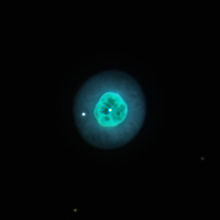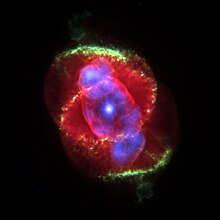| Planetary nebula | |
|---|---|
 | |
| Characteristics | |
| Type | Emission nebula |
| Mass range | 0.1M☉-1M☉[1] |
| Size range | ~1 ly[1] |
| Density | 100 to 10,000 particles per cm3[1] |
| External links | |
| Additional Information | |
| Discovered | 1764, Charles Messier[2] |



A planetary nebula is a type of emission nebula consisting of an expanding, glowing shell of ionized gas ejected from red giant stars late in their lives.[4]
The term "planetary nebula" is a misnomer because they are unrelated to planets. The term originates from the planet-like round shape of these nebulae observed by astronomers through early telescopes. The first usage may have occurred during the 1780s with the English astronomer William Herschel who described these nebulae as resembling planets; however, as early as January 1779, the French astronomer Antoine Darquier de Pellepoix described in his observations of the Ring Nebula, "very dim but perfectly outlined; it is as large as Jupiter and resembles a fading planet".[5][6][7] Though the modern interpretation is different, the old term is still used.
All planetary nebulae form at the end of the life of a star of intermediate mass, about 1-8 solar masses. It is expected that the Sun will form a planetary nebula at the end of its life cycle.[8] They are relatively short-lived phenomena, lasting perhaps a few tens of millennia, compared to considerably longer phases of stellar evolution.[9] Once all of the red giant's atmosphere has been dissipated, energetic ultraviolet radiation from the exposed hot luminous core, called a planetary nebula nucleus (P.N.N.), ionizes the ejected material.[4] Absorbed ultraviolet light then energizes the shell of nebulous gas around the central star, causing it to appear as a brightly coloured planetary nebula.
Planetary nebulae probably play a crucial role in the chemical evolution of the Milky Way by expelling elements into the interstellar medium from stars where those elements were created. Planetary nebulae are observed in more distant galaxies, yielding useful information about their chemical abundances.
Starting from the 1990s, Hubble Space Telescope images revealed that many planetary nebulae have extremely complex and varied morphologies. About one-fifth are roughly spherical, but the majority are not spherically symmetric. The mechanisms that produce such a wide variety of shapes and features are not yet well understood, but binary central stars, stellar winds and magnetic fields may play a role.
- ^ a b c Osterbrock, Donald E.; Ferland, G. J. (2005), Ferland, G. J. (ed.), Astrophysics of gaseous nebulae and active galactic nuclei, University Science Books, ISBN 978-1-891389-34-4
- ^ "Messier 27 (The Dumbbell Nebula)". nasa.gov. 19 Oct 2017.
- ^ Miszalski et al. 2011
- ^ a b Frankowski & Soker 2009, pp. 654–8
- ^ Darquier, A. (1777). Observations astronomiques, faites à Toulouse (Astronomical observations, made in Toulouse). Avignon: J. Aubert; (and Paris: Laporte, etc.).
- ^ Olson, Don; Caglieris, Giovanni Maria (June 2017). "Who Discovered the Ring Nebula?". Sky & Telescope. pp. 32–37.
- ^ Wolfgang Steinicke. "Antoine Darquier de Pellepoix". Retrieved 9 June 2018.
- ^ Daley, Jason (May 8, 2018). "The Sun Will Produce a Beautiful Planetary Nebula When It Dies". Smithsonian Magazine. Retrieved 30 March 2020.
- ^ They are created after the red giant phase, when most of the outer layers of the star have been expelled by strong stellar winds Frew & Parker 2010, pp. 129–148